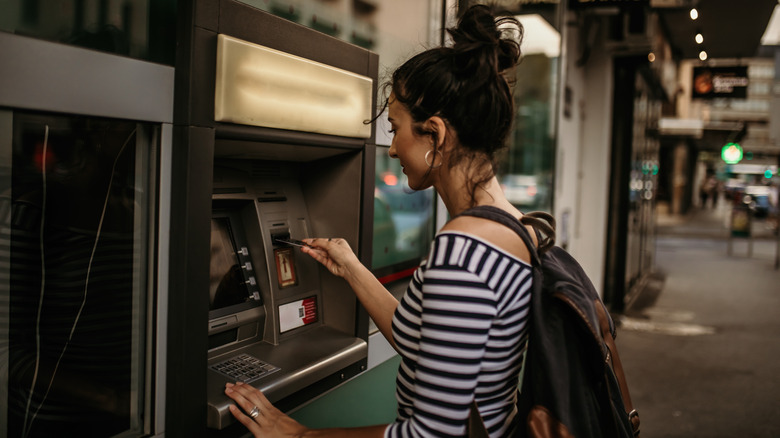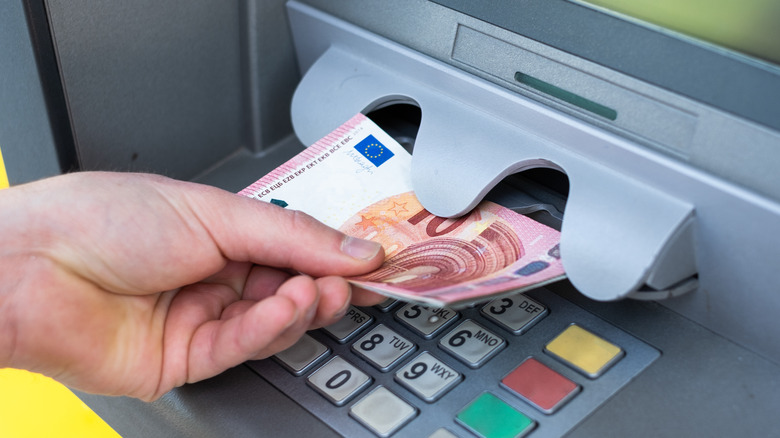Rick Steves' Tips For Protecting Your Money When Using An ATM While Traveling
Blowing through your travel funds while on vacation might sound like something that would only happen while gambling in Las Vegas or going on a spontaneous shopping spree. But you could find your bank account cleared out even if you didn't spend much money, all thanks to one swipe at a bad ATM.
In ATM scams, thieves capture your card information, allowing them to drain your bank account without your knowledge. These traps aren't found only in foreign countries — as of 2022, compromised cards were on the rise in the U.S., according to FICO — but being a tourist in an unknown land might make you even more vulnerable to traps that the locals know to avoid.
Thankfully, world traveler and PBS star Rick Steves has advice for protecting your bank or credit card account while traveling. The "Rick Steves' Europe" host shared his money-saving ATM tips on his website, including the familiar but easily forgotten reminder to always be aware of your surroundings. According to Steves, one of the simplest ways a criminal might steal your card information is simply by watching over your shoulder as you enter your PIN. Similarly, the travel expert says to be cautious if you notice people loitering around the machines. They may be waiting to swoop in and steal your money when you're not paying attention.
Look for card skimmers at ATMs
The ATM at a convenience store or airport might seem trustworthy, but if a thief outfits it with a card skimmer, it can quickly drain your account or credit line — potentially leaving you broke and stranded right in the middle of your vacation. The FBI explains that skimming happens when a scammer attaches an illegal device over a standard card reader. When you insert your card, the skimming device collects and stores the card information. Thieves may also use keypad overlays or hidden cameras to record your PIN number, giving them full access to your account.
Card skimmers can be hard to spot if you don't know what to look for. However, Rick Steves offered a few clear giveaways to travelers via his website. First, he suggested looking for signs of damage on the ATM machine. If the face of the machine seems loose or crooked, it may have been tampered with. Then, inspect the card reader. According to Steves, you may spot a skimmer if the card slot bulges or protrudes out further than other parts of the machine. If you suspect a machine might have a skimmer attached, don't insert your card. Look for another ATM in a safe, well-lit area.
Other ATM problems to watch out for
Unfortunately, the ATM fishiness doesn't end at skimming. Rick Steves also noted a scam where sticky tape or another object is placed inside the ATM card slot, sticking to your card so you can't get it out, as per his website. The scammer then shows up, posing as a helpful passerby and explaining that you just need to enter your PIN again to eject the card. If you follow their advice, you'll retype the number while in their view (giving them a chance to learn your PIN), yet the card still won't come out of the reader. If you eventually decide to give up and leave your card behind, the thieves then have a chance to retrieve it and withdraw money using your account. Moral of the story: Don't trust strangers when it comes to your ATM transactions, according to Steves, and never abandon your card in a faulty machine. Instead, remain at the scene while you call your bank or credit card company to freeze the account.
It's also a good idea to keep track of ATM fees when traveling. In a separate blog post, Steves pointed out that machines that offer to exchange currency may come with hefty conversion rates. Moreover, withdrawal fees for foreign cards can add up, and you might save more by making a few big withdrawals than several smaller ones.


